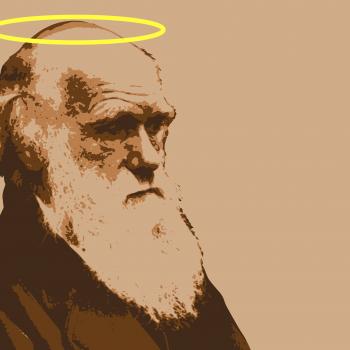I have a new article up at Orbiter Magazine about the relationship between religion and science. Like I’ve done elsewhere, I stress in this article that there are real tensions – cultural conflicts – between these two types of institution. I also go into the personal dimension of what it’s like to be a religious believer who works in the human sciences. In general, science is dedicated to finding causal explanations of natural phenomena – explanations that reduce, at least in theory, to ironclad physical laws. Its main aims are prediction and control of the natural world. By contrast, religious life has goals such as making sense of one’s personal life within a narrative framework that enhances meaning and creates community. These aren’t the same goals. They’re by no means inherently incompatible, but they do give rise to specialized cultures with very different values. And cultures with different values often clash.
There’s no inherent conflict between any two cultures. No deep-set logical reason exists why Turks and Greeks should dislike each other, or why Wisconsin football fans and Minnesota football fans should get into drunken brawls. Yet Greece and Turkey do, in fact, have a fraught relationship, and the Universities of Minnesota and Wisconsin are fierce rivals. Cultural conflict isn’t based on logic; it’s based on culture. And culture is a complex mishmash of history, rituals, traditions, language, religion, geography, and more.
For example, today’s cultural and political tensions between Turkey and Greece reflect a thousand years’ worth of military struggles, imperial ambitions, and bitter religious conflicts. Greek-speaking Byzantines and Muslim Seljuk Turks were already fighting fiercely over Anatolian territory in the 1060s. Over the centuries, various Turkish kingdoms slowly chipped away at the Byzantine Empire, until the Ottomans conquered Constantinople in 1453, expelled the Byzantine Greeks, and renamed the city Istanbul. Since then, there have been periodic ethnic cleansings and expulsions, continued conflicts, and diplomatic tensions between Greece and Turkey, the modern successor states of these old empires. So it makes no sense to look for an abstract, logical reason for the tense relations between these two nations. The tensions exist for particular reasons, rooted in historical and cultural contingencies.
Similarly, religion and science are not necessarily incompatible on epistemic or logical grounds. Extremist stereotypes, such as science-fearing Bible-thumpers or religion-hating, atheist scientists, are mostly exaggerations, as careful research by sociologists Elaine Ecklund and Christopher Scheitle shows. (I discuss Ecklund’s and Scheitle’s work in my Orbiter article.) But it will take more than doing away with stereotypes – or disproving the logical incompatibility of faith and reason – to solve the cultural clash between science and religion. Logic isn’t the operative principle here. Science produces a culture of people who are focused on taking the world apart, finding physical causes for things, and solving technical problems. Religion produces a culture of people who care more about the personal and the social dimensions of reality, following social norms, caring for the in-group, and making sense of suffering.
This last focus – suffering – is the source of some of the biggest rifts between the two types of culture. Science as a social institution is built on a kind of radical optimism. It’s powered by the belief that problems can be solved, damn it. If we apply careful reason and experimentation, then we can learn how to feed 10 billion people, or how to build food replicators, or how to go to Mars. When the world throws problems at us – measles, starvation, ozone holes– then we roll up our sleeves, get some grant funding, and slash through those problems like William Wallace through a cluster of terrified English.
So, within the culture of science, the problem of suffering isn’t a “problem” in a unified sense at all. It’s actually a series of discrete but ultimately solvable challenges. Illnesses, poverty, even aging itself are potentially all amenable to creative, technical solutions. The scientific way to deal with pain and suffering is to apply our technical wizardry and scientific genius, and so to triumph over the irksome problems that cause them.
This optimism has powered the modern world. Since the Age of Enlightenment, our staggering technological advancements and exponentially improved living standards have all grown up from the rich soil of systematic, experimental problem-solving. This systematic experimentation itself is only possible when scientists and funders alike are confident that it will pay off to attack problems using the tools of science. And it does keep paying off. So our scientific confidence builds on itself, in a kind of virtuous cycle that has run on the scale of centuries.
By contrast, many religious traditions are built on very different foundational premisses. Not only is suffering inescapable, but it is among the most important facts about reality. We all suffer loss and bereavement, know the pain of insecurity and rejection, and eventually experience the ignominy of death. So being religious is a kind of admission that the core problems of life are not, in fact, amenable to technical solutions.
Yes, sure, we can probably increase grain yields for cereal crops by manipulating the DNA of wheat. We can improve the efficiency of solid-state memory storage. We can find new drugs that are effective against antibiotic-resistant bacteria. But the religious claim is that, despite all these good things that science affords, the basic predicament of life does not and will not change – we are temporary, flitting creatures, living out precarious lives in a world wracked by pain.
As such, suffering is a given – a basic existential fact that needs to be incorporated into one’s model of the world, not a problem that can be vanquished. Particular sources of suffering can be ameliorated or even done away with, using technical skills and scientific ingenuity. But the reward systems in our brains are set up to ensure that our hedonic balance – how good we feel – always returns to a mean. We habituate even to ideal circumstances. And the basic disappointments of life, from social rejection to death itself, still dog us wherever we go. We are never going to be free of pain.
At its worst, this religious acknowledgment of suffering leads to quietism – a shrugging surrender to the vagaries of life. But at its best, it teaches humility, and encourages finding sources of satisfaction in life that don’t depend on mastering our environments or rising victorious over life’s ills. So when believers gather together, they’ll probably spend at least some time talking about problems and sources of sadness.
For example, many Protestant churches set aside time during Sunday services for parishioners to pray aloud for things that are on their minds. Quite often, these prayers have centrally to do with suffering – one person’s mother has cancer, another person’s hometown just got hit by a tornado.
Just hearing these prayers uttered, one by one, in corners of the otherwise silent sanctuary can be a powerful and harrowing experience. You’ve just walked into, say, an Episcopal church, where the congregation is well-dressed and comfortable-looking (if a bit gray-haired), and yet here you are discovering that all these seemingly secure, prosperous people are carrying around enormous, unexpected sorrows and secret pains. It’s as if daily life is a hardened scab, and petitionary prayer lifts it up to expose startlingly soft and vulnerable skin underneath. For a moment, you realize the sheer amount of hurting that is going on, at every moment, everywhere in the world, and it shakes you to the core.
Religious settings, for all their many failings, allow us to just face this fact. This is in part why the central symbol for Christianity is a dead man on a cross. It’s why the First Noble Truth of Buddhism is that life is dukkha, or suffering, and why Hindus believe we’re living in the Kali Yuga, the age of darkness.
The culture of science is just another beast entirely. There, omnipresent technological and experimental optimism underlies a shared, common conviction that problems can be solved, but this conviction in turn can often subtly discourage people from expressing their basic human frailties, or even sharing personal disappointments. True, scientists – like any professionals – love to vent and complain to one another. Someone didn’t get funding, or someone else’s lab is run incompetently. But truly lamenting the unutterable pain of losing a loved one? That’s not so common. Responses to news of personal tragedies tend to be of the stern, moment-of-silence, British-colonial-officer variety, followed by a barely concealed anxiousness to get back to (talking about) work.
Of course, this difference in approaches to personal suffering is in part simply the difference between a personal community and a professional one. If you’re a lawyer out for drinks with your firm, you’ll probably hold back on discussing the travails of your father’s recent stroke. So in a sense, I’m just pointing out that different communities have different norms, and it’s perfectly natural that a professional community will have more boundaries about personal oversharing.
But science is more than just another professional community. It’s also arguably the institution that anchors the entire post-Enlightenment liberal project – our centuries-long experiment in building societies based on liberty, democracy, and the search for rational solutions to problems. So the values of science – the mistrust of tradition, the entrenched technological optimism – consistently bleed out into the surrounding culture. There, they can’t help but butt up against the values of religious traditions, which generally uphold tradition and, being aware of the reality of suffering, are wary of excessive melioristic optimism.
Optimism and refusal to wallow in defeat are important for science. Science wouldn’t function without them. But just as certainly, religion wouldn’t be religion without a healthy dose of skepticism towards technical solutions to life’s core problems, and a willingness to ritually acknowledge the defeats and sufferings of life. In principle, these different modes of dealing with life’s problems are perfectly capable of peacefully cohabiting, just as the culture of lawyers coexists just fine with the culture of academic researchers. But in actual practice, the core position science holds in our society’s systemic ideology ensures that cultural clashes with religions – which are themselves key sources of ideology – are inevitable.
I may be religious myself, but I’m trained in religious studies and the scientific study of religion, which are secular approaches to the phenomena of human religion. I’m not arguing for the validity of my own or anyone else’s beliefs. Instead, I’m using my knowledge of how cultures and institutions work to point out that the tensions between science and religion don’t always come from the places that get the most attention, such as incompatible beliefs about the world, although – as I point out in my Orbiter piece – incompatible beliefs are certainly part of it. Scientists are obliged to see the world as a system of interlocking causal events, driven by inflexible natural laws. Religious worldviews see the world as something more like a story. Thus, as thinkers such as Stewart Guthrie have argued, religious thought really is more anthropomorphic – it presents the world as a network of characters, each with intentions, purposes, and goals. Such anthropomorphic concepts are not useful in scientific labor.
But these different axioms and approaches aren’t really behind the most serious tensions between religion and science, at least not in a direct way. Chemistry works on different assumptions than, say, art history, but there’s no big clash between those two domains. Instead, it’s the contingent historical relationship between scientific and religious cultures – a relationship that has built up, over time, from very different approaches to understanding the world and the countless personal interactions and institutional strains that resulted. These different approaches feed back to motivate different social norms and mores, and if there’s anything history teaches us, it’s that two cultures with very different norms and mores that are also in competition for important positions of power or influence will end up in conflict.
In order to understand the tensions between religion and science, we need to understand more than just their different conclusions about reality. We need to understand their human – and, yes, their historical and political – dimensions. Just like a conflict between any two nations can’t really be fathomed without a decent awareness of their historical relations and their unique economic, social, and cultural circumstances, so too the relationship between religion and science is more than just a clash between two different systems of knowledge. It’s the long, slow working out of a massive experiment in fundamentally changing the way we live, overlain with the countless personal tensions and crises that come along with it.













